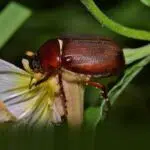June Bug Day is rightly observed on June 7. June bugs, a part of the Phyllophaga genus, are most visible this month. They spring up from the ground, searching for food and a mate at this time of year. They spend up to three years in the ground as larvae. Adults are about an inch or shorter, with a hard brown or black casing and wings. They hide in trees during the day, but at dusk, they swarm and are attracted to light. It is also when they are actively feeding on trees and bushes.
History of June Bug Day
June bugs are a type of beetle, and they exist in quite a wide variety. The word ‘June bug’ refers to any of about 100 species of beetles in the family of scarabs. They are of the genus Phyllophaga and the order of Coleoptera. Another common name for the June bug is either ‘June beetle’ or ‘May beetle.’ The common June bug measures between one-half and five-eighths of an inch, and its color is reddish-brown. As with every other beetle, it also has shiny wing covers, which are called ‘elytra.’ June bugs can cause damage to gardens, lawns, and pastures, but can generally be controlled with prescribed pesticides. June bugs are regarded as chafers, because they feed on vegetation, particularly leaves. The diet of a June bug can further comprise grass, flowers, fruit, and food crops such as grains. They are also known to consume decaying organic material as part of their diet. It is this leaf-eating characteristic that is responsible for their scientific name ‘Phyllophaga,’ which is the Greek expression for ‘leaf eater.’ June bugs are nocturnal, meaning that they are typically most active after nightfall and before dawn. They usually feed from dusk through the evening, to avoid predators. June bugs are so-called because their adults emerge from the soil at the end of spring or the beginning of the summer, which is in June.
The females bury their eggs just below the surface of the soil. June bug larvae typically hatch within three to four weeks and then feed on grass and plant roots from their formative months and for as long as three years. In spring and early summer, the larvae grow into pupae and mature into adults in a space of three weeks.
Adult June bugs are generally harmless. But their attraction to light makes them a nuisance to humans. Even light from inside the home can attract June bugs in large numbers. The sound of June bugs bumping and buzzing against window screens is closely associated with summer in many parts of the United States. Scientists and researchers are yet to come up with an explanation for this particular behavior, and although several hypotheses have been advanced, no single theory can account for any reason for which different nocturnal insect species gravitate toward sources of illumination.
June Bug Day timeline
Race Car driver Dale Earnhardt, nicknamed ‘June Bug,’ is born.
“Junebug,” an American comedy-drama film directed by Phil Morrison, is released.
The game Kentucky Route Zero, in which one of the characters is called Junebug, is developed.
The viral dance challenge called ‘the Junebug challenge’ is created and trends on the internet.
June Bug Day FAQs
Are June bugs the same as cockroaches?
June bugs look like roaches, but they’re rounder.
Are June bugs annoying?
A few June bugs fluttering about isn’t a huge problem, and if anything, they’re just a little irritating. Adult June bugs may be a nuisance in the late hours for most people, being clumsy flyers that may crash with people, windows, and other things.
Are June bugs only in Canada?
June bugs, also referred to as May bugs, are scarab beetles found throughout North America.
June Bug Day Activities
Turn on an outside light
The ideal way to commemorate June Bug Day is to put on an outside light at night. Having done this, watch how June bugs congregate near the light.
Share on social media
Celebrate this day by posting on social media, using the hashtag #JuneBugDay. Encourage your friends and followers to join the celebration.
Learn how to control June bugs
Another way to celebrate June Bug Day is to research ways to control the June bugs. There are a few simple but effective methods you can use to reduce the number of June bugs in our homes.
5 Facts About June Bugs
Nobody knows why they love lights
Scientists are baffled by the June bug's irrational love of electric lighting.
They can live underground
The June bug's white, grub-like larva can survive in the soil for up to three years.
They have a spare pair of wings
These infamously clumsy flyers have two sets of wings; only one of the combinations offers what scientists refer to as lift.
June bugs are beetles
June bugs are part of the large and varied group of insects known as beetles.
June beetle is a common name
The common term for scarab beetles, which appear in June in subtropical and tropical parts of North America, is June beetle.
Why We Love June Bug Day
They are animal feed
Many wild creatures, including skunks, raccoons, and various bird species, eat June bugs at different life cycle phases. Hence June bug’s economic importance to animals.
They aid in the cycling of nutrients through ecosystems
Although many people dislike June bugs, they serve a crucial role in ecosystem nutrient cycling. Nutrient cycles keep the ecosystem in equilibrium.
Some individuals consume June bugs
Wild-foraging insects, such as June bugs, may also be essential in providing nutrients for human consumption. Some people regard them as the ‘croutons of the sky.’
June Bug Day dates
| Year | Date | Day |
|---|---|---|
| 2026 | June 7 | Sunday |
| 2027 | June 7 | Monday |
| 2028 | June 7 | Wednesday |
| 2029 | June 7 | Thursday |
| 2030 | June 7 | Friday |























